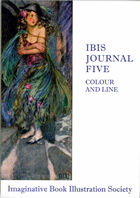
IBIS Journal 5: Colour and Line

This Journal has articles on three very different artists working in different styles together with an essay on an exceptional series of illustrated books.
Eleanor Fortescue Brickdale started her career as an illustrator with a series of books illustrated in line, but then enthusiastically grasped the opportunities offered by the four-colour process. While she was strongly influenced by the Pre-Raphaelites and by her friend and mentor Byam Shaw, she produced a distinctly original body of work that also drew on both Italian renaissance painting and later symbolist works. John Howe and Ann Carling show how she had to fight against contemporary views of the place of women in art to claim a place alongside her male counterparts.
Alfred Walter Bayes was also much influenced by the illustrators of the Pre‑Raphaelite school. He was a protégé of the Dalziel Brothers and produced a large number of designs for them. He is of special note as the first illustrator of Hans Andersen’s works in England. He preferred to illustrate moments of contemplation or of inner turmoil, rather than physical action. The books that he illustrated were immensely popular during his lifetime, although many of them credited the engravers rather than the artist and today he is almost forgotten. Simon Cooke provides a guide to the influences that shaped the designs of this neglected artist and supplies the first full bibliography of his published work.
During the 1890s and early 1900s most illustrated books were limited to black and white. The majority of readers and critics were content with these volumes as they were, but a few hankered after colour. Gloria Cardew, a young art student, discovered that she had a talent for adding sensitive watercolour tints to printed illustrations. For a few years she offered a service to those who could afford it, hand colouring de luxe editions of illustrated books, either for the bookseller Frank Karslake or dealing directly with the owners. Denis Collins gives us an account of this phenomenon and lists the titles that were so coloured.
At the same time as Miss Brickdale was painting her pre-Raphaelite influenced illustrations, the artists of the Vienna Secession were producing editions of classic texts with what at the time must have seemed to be shockingly avante garde designs. Much prized today, the little volumes of the Jugendbücherei series published by Martin Gerlach between 1901 and 1920 provide a brilliant cross-section of the graphic art of that time and place. Josef Woelwer draws on his personal collection to set this brilliant publishing venture in context and to list the titles and artists involved.
The journal has 144 pages, numerous illustrations, many in colour, handsomely bound in glossy covers.
Copies of Journal 5 may be purchased by members and non-members. Click on "How to Buy" in the menu on the left for more details.